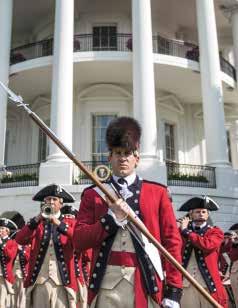THE OLD GUARD Fife and Drum Corps AT THE WHITE HOUSE
Providing the Soundtrack to America’s Story
ROSS D. ANDREWS, J. MARK REILLY, AND WILLIAM E. WHITE JR.
at every state arrival ceremony, there is a moment when the president and the visiting head of state are “alone” for the first time. Every second up to this one has been carefully choreographed and stage-managed, the greetings mandated by protocol. The scene is often stiff and formal. Then the Old Guard Fife and Drum Corps—distinctive in their red coats, tricorn hats, and white wigs—steps off and begins to play. Invariably, during this part of the pomp and ceremony, the president and visiting head of state engage in a moment of spontaneous conversation. Often the president will lean a bit toward his guest and say a few words, and the guest will respond, perhaps with the first genuine, unscripted smile. It is a moment of humanity between two world leaders facilitated by a military music organization that harkens back to George Washington, the Continental Army, and the ideals and values on which the United States was founded. This is the United States Army Old Guard Fife and Drum Corps.
9 white house history quarterly
OPPOSITE: U.S. ARMY PHOTO BY SERGEANT NICHOLAS T. HOLMES / RIGHT: GETTY IMAGES
During the American Revolution, George Washington created the Continental Army from the ground up. The number and variety of issues he faced were mind-boggling, and his correspondence makes it clear that he was personally involved in nearly every detail of this great work. Fife and drum, more accurately referred to in this context as field music, was no exception. General Washington personally appointed the first inspector of music for the army, Lieutenant John Hiwell, and provided multiple instructions for how field musicians were to perform certain ceremonies that regulated the army’s daily activities.1
The daily duties for the eighteenth–century fifer and drummer included signaling all the army’s activities in camp including reveille (a soldier’s wake-up alarm clock), roll call, mess call (time to eat), church call, wood call, water call, to arms (collect weapons), surgeon’s call (call for the surgeon), retreat (played at sunset, the close of official duties), and tattoo (turn off the ale taps and return to bed).
On the battlefield, the fifer, drummer, or bugler was the voice of the commander, sounding quick march, charge, retreat, prime and load, fire, right/ left wheel, and all major movements of the army. These calls are codified in Baron von Steuben’s Blue Book used by George Washington’s Continental Army and later refined in 1812 by Charles Stewart Ashworth. Ashworth’s A New Useful and Complete System of Drum Beating is considered by many to be the first American military fifing and drumming manual.
By the mid-twentieth century, field music fell out of use by the military, supplanted by the much more efficient radio. In 1960, however, the U.S. Army Military District of Washington formed the Old Guard Fife and Drum Corps to pay homage to the Founding Fathers and the earliest days of the army by reviving the nation’s musical heritage. Though George Washington never lived in the White House during his presidency, the exacting standards he established for field music during the American Revolution live on in the Old Guard Fife and Drum Corps. Assigned to the famed “Old Guard,” the Third U.S. Infantry Regiment, the soldier-musicians of the Fife and Drum Corps are part of the elite unit charged with guarding the Tomb of the Unknowns, carrying fallen warriors to their final resting place in Arlington National Cemetery, representing the U.S. Army to American citizens around the country, and representing the nation
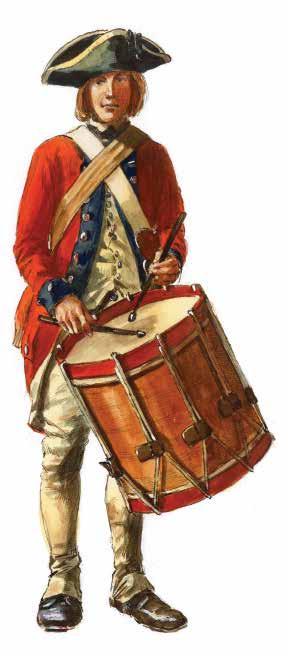
around the world. The corps today includes sixty-nine performing members and one officer chosen through an extensive two-part audition. The first round includes musical performances, and the second involves a marching drill, a standing test, and a professional interview.
The instruments the members play today are adapted from the eighteenth-century fully chromatic ten-hole nonkeyed fife, a two-valve bugle, and rope tension snare and bass drums. The music performed by the corps is a mixture of eighteenthand nineteenth-century traditional American military ceremonial music and approved modernized arrangements. The corps production staff conducts musical and historical research through the unit’s Center for Martial Music, a physical and digital library of military music manuscripts from around the world.
previous spread
The Old Guard Fife and Drum Corps performs on the South Lawn during the 2019 White House Easter Egg Roll, and President Barack Obama shares an unscripted moment with Canadian Prime Minister Justin Trudeau as the Old Guard Fife and Drum Corps marches past them during a State Arrival Ceremony, March 10, 2016.
left
A drummer of the Continental Army in uniform. Musicians customarily dressed in the reverse colors of their regiments.
10 ILLUSTRATION BY DON TROIANI FOR THE NATIONAL PARK SERVICE white house history quarterly

A music book containing approximately fifty patriotic tunes was inscribed in 1776 as belonging to musician William Morris of New Jersey’s First Regiment. right
A restored snare drum is believed to have been carried by Luther W. Clark at the Battle of Guilford Courthouse in North Carolina.
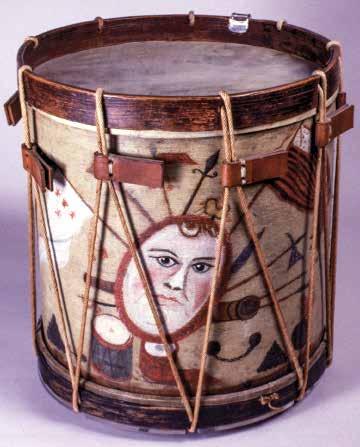
11 white house history quarterly TOP: NEW-YORK HISTORICAL SOCIETY / BOTTOM: GUILFORD COURTHOUSE NATIONAL MILITARY PARK, NATIONAL PARK SERVICE above

left
Archibald Willard’s iconic painting, The Spirit of ’76, pictures the fife and drum musicians of the Continental Army on the battlefield. While creating the painting for the 1876 Centennial Exposition in Philadelphia, Willard was intent on conveying the courage and determination of the patriots. He chose his father as a model for the central drummer, and a farmer and schoolboy for the figures on either side. Several copies were made of the painting. The original is in Abbot Hall in Marblehead, Massachusetts.
12 WIKIPEDIA white house history quarterly

The Old Guard Fife and Drum Corps marches down Pennsylvania Avenue from the U.S. Capitol toward the White House in the Inaugural Parade for President Barack Obama, January 21, 2013.
As part of its duties, the Old Guard Fife and Drum Corps provides various ceremonial services to the president and the White House. On Inauguration Day it is part of the military honor guard that escorts the president and vice president from the U.S. Capitol to the White House. The Fife and Drum Corps has marched in every Inaugural Parade since John F. Kennedy’s in 1961. In addition to the Inaugural Parade, the Fife and Drum Corps performs at inaugural galas and balls. During the administration of Richard M. Nixon, the Fife and Drum Corps provided music for credential ceremonies in which newly arrived foreign ambassadors to the United States formally presented their credentials to the president. President Gerald R. Ford used the Fife and Drum Corps for departing music when dignitaries visited the Oval Office. Sergeant
Corps Major John Oktavec, former fifer in the corps, remembers:
The corps was positioned opposite the Oval Office on the South Lawn and played selections while the president escorted a visiting dignitary from the Oval Office to a waiting vehicle. Our instructions were to play from the moment the door opened until the president returned to the Oval Office. On one occasion, President Ford started walking back to the office but then he stopped and turned toward the corps and stayed a little while enjoying the music. We had no idea how long he was going to stand and listen, so we just followed our instructions and kept playing until he continued on and entered the Oval Office.2
13 white house history quarterly DEPARTMENT OF DEFENSE PHOTO BY E.J. HERSOM
above

A fife and drum corps marches in the Inaugural Parade for President William Howard Taft (left), March 4, 1909, and the Old Guard Fife and Drum Corps performs during the Inaugural Parade for President John F. Kennedy (opposite), January 20, 1961. The Old Guard Fife and Drum Corps has participated in every Inaugural Parade since 1961.
14 white house history quarterly
ALAMY
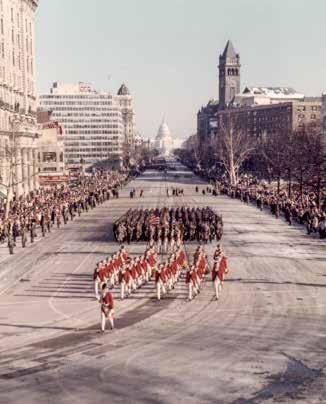
15 white house history quarterly JOHN F. KENNEDY PRESIDENTIAL LIBRARY AND MUSEUM
In the 1980s, the Fife and Drum Corps became a standard component of the State Arrival Ceremonies held on the South Lawn of the White House. With a “Troop in Review,” the corps renders honors to the president and visiting head of state with its distinctive halfspeed march, the stately “Troop Step,” and “Yankee Doodle.” In these ceremonies the corps is a visual and audible representation of the founding spirit and ideals of the United States.
The corps’ contribution has become so important to the ceremony that in 2008, when the ceremony was completely reconfigured for Pope Benedict XVI to remove the standard military formation, the Fife and Drum Corps was one of the only military units still participating.
Over the last sixty-four years the Fife and Drum Corps has also performed for other occasions and developed special relationships with first families. The Kennedys particularly seemed to appreciate the Fife and Drum Corps’ performances, requesting them for numerous events including First Lady Jacqueline Kennedy’s Musical Program for Youth by Youth series, receptions at the White House for visiting dignitaries, and once, in 1961, for a special State Arrival event for the president of Pakistan, hosted by President Kennedy at Mount Vernon. Mrs. Kennedy specifically requested the Old Guard Fife and Drum Corps’ participation in her husband’s funeral procession. After the funeral, each member of the corps received a special memento, “a Kennedy half-dollar encased in a blue velvet bag,” said Richard Cross, former snare drummer, “because [the Kennedys] loved the Corps and we were their favorite.”3
President Joe Biden and Australia’s Prime Minister Anthony Albanese watch as the Old Guard Fife and Drum Corps performs during a State Arrival Ceremony at the White House, October 25, 2023.

16 white house history quarterly

17 white house history quarterly AP IMAGES

President George W. Bush and Pope Benedict XVI observe a performance by the Old Guard Fife and Drum Corps during an Arrival Ceremony on the South Lawn in honor of the pope, April 16, 2008. The Old Guard Fife and Drum Corps was one of the only military units to perform in the ceremony.
18 white house history quarterly
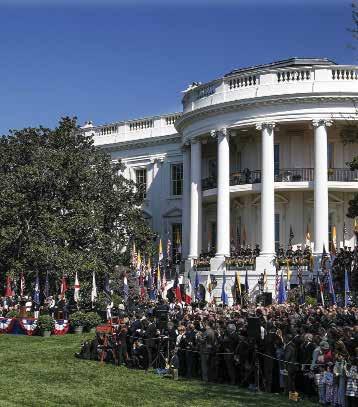
19 white house history quarterly AP IMAGES
In 2008, when the George W. Bushes’ White House holiday decoration theme was “A Red, White and Blue Christmas,” the decorations included drums and flutes, and the traditional gingerbread White House featured “cookies fashioned after the Old Guard Fife and Drum Corps.”4 During two holiday receptions hosted by the Bushes, the Fife and Drum Corps paraded inside the house for the entertainment of the guests. The Fife and Drum Corps has been a frequent participant at the annual White House Easter Egg Roll, Fourth of July celebrations, and various other events as well.
The Fife and Drum Corps’ unique honor to support the president naturally creates cherished personal memories for members of the corps. Former bass drummer William Bub recalls a particular performance in 1969. “My first performance was on the White House steps, for a senior citizen dinner on Thanksgiving Day, 1969. We played when they went in for their meal . . . and then played again when they left.” It is part of a musician’s lot to work on holidays, but Bub adds, “To be fair, we did get a nice Thanksgiving meal that evening.”5
The Reagans, like the Kennedys, were particularly fond of the Fife and Drum Corps. Former bugler and drum major Steven Phipps recalled a State Arrival Ceremony in 1984.
About twenty minutes before [the ceremony], the crowd on the lawn started applauding, and President Reagan soon appeared coming towards the corps. The president said, “Hello Sergeant,” and reached out to shake my hand. I shook his hand and said, “Hello Mr. President, nice to meet you,” and he said, “Well, it’s nice to meet you too.” He then stepped beside me and talked to the corps, thanking the musicians for their service. He then moved on to the other units on the lawn, but he didn’t spend as much time with them as he did with the corps. Needless to say, I haven’t washed my hand since!6
Following the 1985 Inauguration the Fife and Drum Corps received a letter from the president: “Nancy and I have an especially warm spot in our hearts for entertainers, and your participation in [the inaugural galas] did a lot to ward off the chill Mother Nature had contributed!”7
A later drum major had a slightly different “personal moment” with President George W. Bush. Former bugler and drum major Russell Smith

recalled the Fife and Drum performance at a holiday reception hosted by the George W. Bushes. It’s tight inside the White House because of all of the Christmas guests. Marching down the main hallway all I see is this giant chandelier, right where I need to swing the espontoon [the long pole used to direct the movement of the corps] for the countermarch signal. As I give the signal and began my spin to head back through the corps, dead even with me is President George W. Bush looking up at the chandelier. I don’t know if he was in awe or ready to save someone’s life if I were to knock that thing down, but the chandelier survived, and I was very happy that I didn’t destroy part of the White House!8
These personal memories of service at the White House suggest why the Old Guard Fife and Drum Corps is such a natural partner of the White House and a symbol of what the presidency represents. All three institutions—the White House, the presidency itself, and the Old Guard Fife and Drum Corps—evoke a strong sense of nationalism, patriotism, and pride. Simply being in the presence of any, much less all three at the same time, can be a powerful patriotic experience.
Members of the Old Guard Fife and Drum Corps are represented in marzipan as part of the 2008 White House holiday decorations. The theme was “A Red, White and Blue Christmas.”
20 white house history quarterly SHUTTERSTOCK

The Old Guard Fife and Drum Corps performs for guests at the 2019 White House Easter Egg Roll.
Because of its important symbolism, the Fife and Drum Corps has often been incorporated into significant events hosted by the president outside the White House Grounds as well. In the 1980s, President Reagan hosted the G7 Summit in Williamsburg, Virginia, and President George H. W. Bush hosted the G7 Summit in Houston, Texas. The Fife and Drum Corps traveled to both locations to provide its unique tribute and American cultural flavor as these presidents first greeted multiple heads of state arriving for the summits. Likewise, in 2020, when President Donald Trump chose to travel to Fort McHenry, Maryland, as part of Memorial Day commemorations, the Fife and Drum Corps was asked to provide a performance that would add to the patriotism of the event.
For sixty-four years the Old Guard Fife and Drum Corps has supported the president and the White House, providing the soundtrack to America’s story. The sight of tricorn hats and the sounds of fifes, bugles, and drums evoke our founding principles and stir patriotic emotions. Sometimes that stokes the patriotism of America’s youth at the annual Easter Egg Roll and sometimes it facilitates a small moment of diplomacy between world leaders during an otherwise highly scripted and formal ceremony. Always, for the members of the Old Guard Fife and Drum Corps, performing at the White House is very simply an honor. John
Oktavec, who served in the corps for thirty years, sums it up perfectly: “Every time I set foot on that lawn regardless of what the event was, I always thought, ‘I can’t believe I’m here. I remember watching this stuff on TV growing up and now I’m here, representing the United States of America.’ That’s something you’ll never forget.”9
notes
1. George Washington, general orders dated August 19, September 3, and September 12, 1778, The Writings of George Washington from the Original Manuscript Sources, ed. John C. Fitzpatrick et al. (Washington D.C.: Government Printing Office, 1931), 12:337, 393, 429.
2. John Oktavec, telephone interview by author William E. White Jr., August 28, 2021.
3. Richard Cross, e-mail message to author William E. White Jr., August 27, 2021.
4. “A Red, White and Blue Christmas,” White House Holiday Decorations fact sheet, December 3, 2008, President George W. Bush website, https://georgewbush-whitehouse.archives.gov.
5. Quoted in Ross Andrews, “Old Guard Fife and Drum Corps Alumni: Symbolizing Freedom to the World Since 1960,” 55 (unpublished, 2003), copy in U.S. Army Old Guard Fife and Drum Corps Center for Martial Music, Joint Base Myer–Henderson Hall, Arlington, Va.
6. Steven Phipps, e-mail message to author William E. White Jr., August 26, 2021.
7. Ronald Reagan to members of the Old Guard Fife and Drum Corps, February 5, 1985, General Collection, Center for Martial Music.
8. Russell Smith, e-mail message to author William E. White Jr., August 27, 2021. An oral history of the U.S. Army Old Guard Fife and Drum Corps is in the digital library collection compiled by William E. White Jr., Center for Martial Music.
9. Oktavec interview.
21 white house history quarterly
WHITE HOUSE PHOTO
